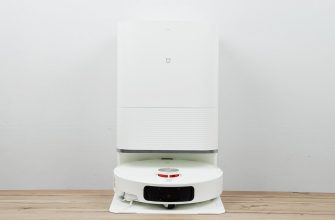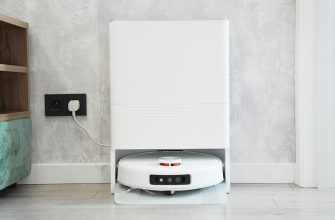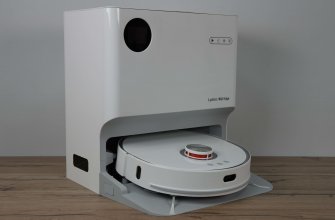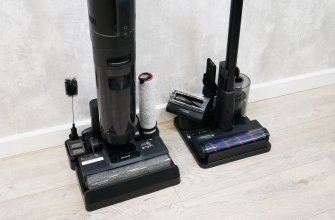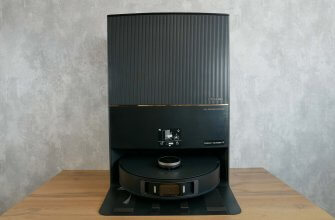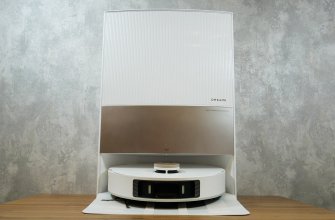Hi everyone! Welcome to the Robotobzor! Today we will take a look at one of the most anticipated and functional robot vacuum cleaners of 2022. We are talking about Xiaomi Mijia Omni Robot Vacuum-Mop B101CN. At a cost of about $650-750, just listen to what this device can offer. On board, it not only has a lidar, but also a sensor system for detecting objects on the floor. The cleaning module is represented by a side and a central brush, behind which are placed two rotating microfiber mopping pads. These mopping pads can automatically rise when driving on carpets. And what’s more, the robot vacuum cleaner itself is equipped with a station where it automatically self-cleans, rinses mopping pads and dries them with hot air. In general, this is a top-end set of solutions that greatly simplifies the maintenance of the robot and improves the quality of cleaning. Next, I will test the Mijia Omni in detail, after which I will express my own opinion on how well it copes with its main task and whether it can be considered the best in its price range segment. Let’s go!
Equipment
The delivery set, in addition to the robot itself and the station, includes:
- Power adapter with an adapter for a euro socket.
- Operating instructions in Chinese.
- Spare bag for the station.
- A robot cleaning tool.
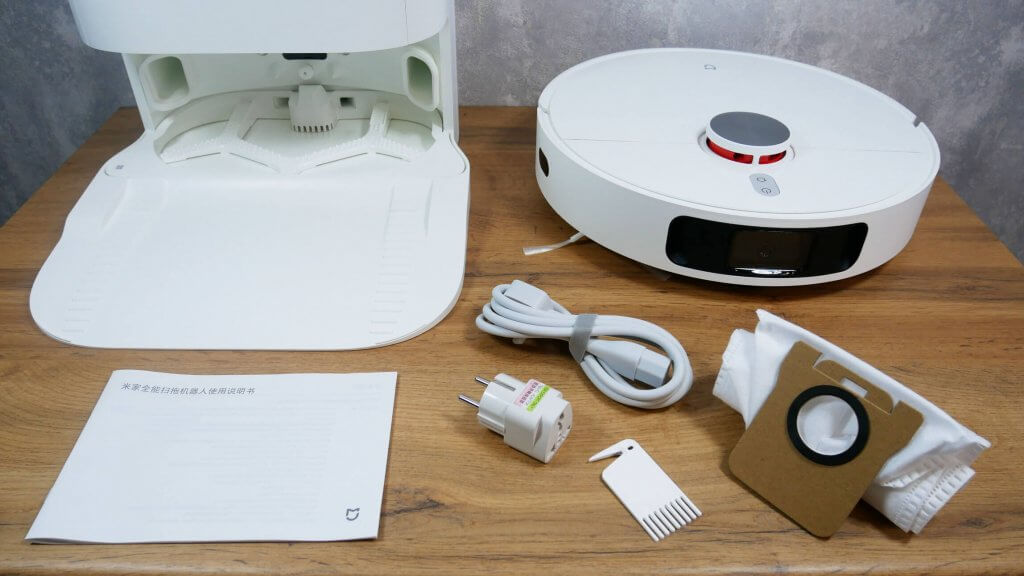
Equipment as always minimal. Let`s move on!
Design
Let`s have a look at the design of Xiaomi Mijia Omni Robot Vacuum-Mop B101CN. I will point out right away that at first sight it is an absolute copy of the Dreame Bot L10s Ultra, a review of which has already been published on the channel. But we have to admit that Mijia Omni was released six months earlier. The differences are minimal, but there are, we’ll talk about this later.
Let’s start the review with the robot vacuum cleaner itself. It is made in white. The body shape is round. Case height 97 mm from the floor.
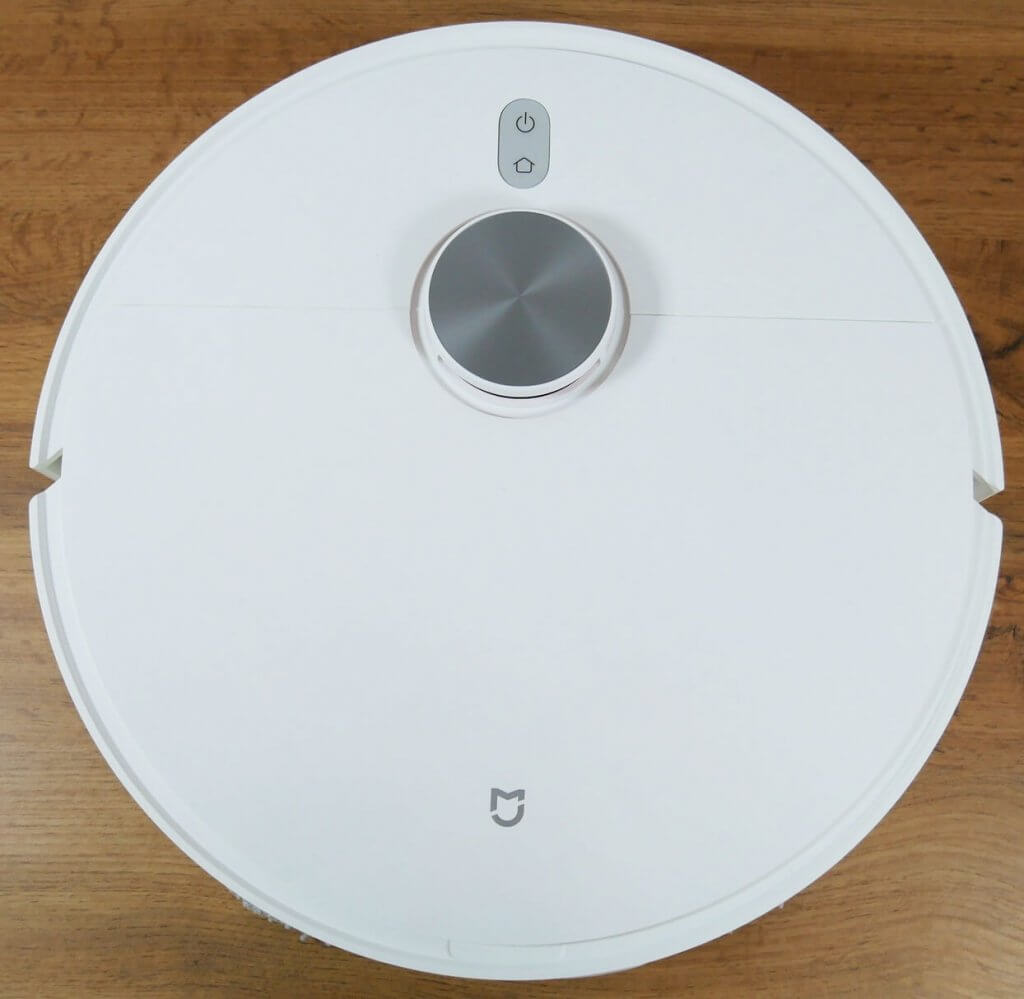
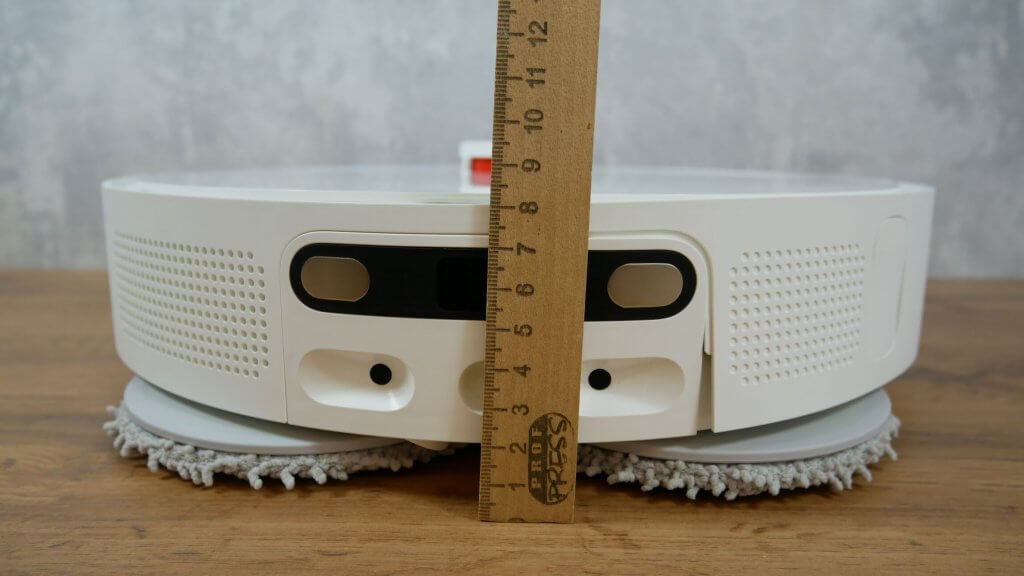
A wall sensor is installed on the right side of the mechanical bumper. A system of sensors is placed in the center to detect and accurately avoid objects on the floor.
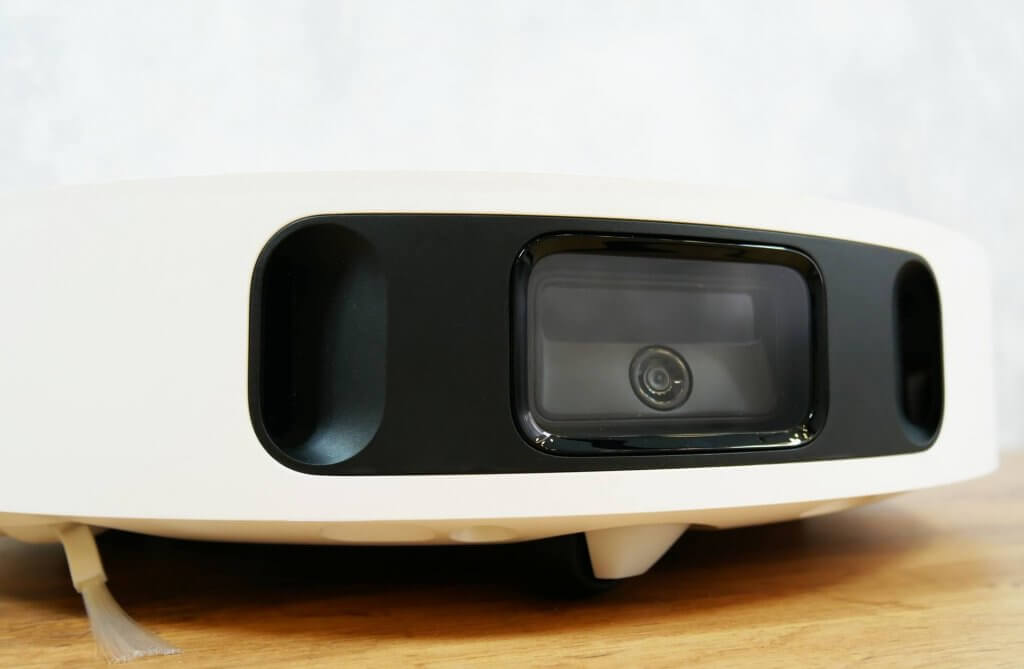
There are two mechanical buttons on the control panel. Lidar is equipped with a spring-loaded cover that protects the robot from getting stuck under furniture. Under the top cover there is a dust collector. We see that the manufacturer allows the container and the HEPA filter to be washed with water, which is a plus. Filtration system based on mesh and HEPA filter. The water tank is placed inside the case. It holds up to 80 ml of water. Water is pumped into the robot automatically at the station.

4 protection sensors are installed on the bottom of the case from falling from a height. The side brush is one, three-beam, quick-detachable. The block of the central brush is floating. The brush itself is bristly-petal. On both sides, it is disassembled for cleaning from wound hair and wool.

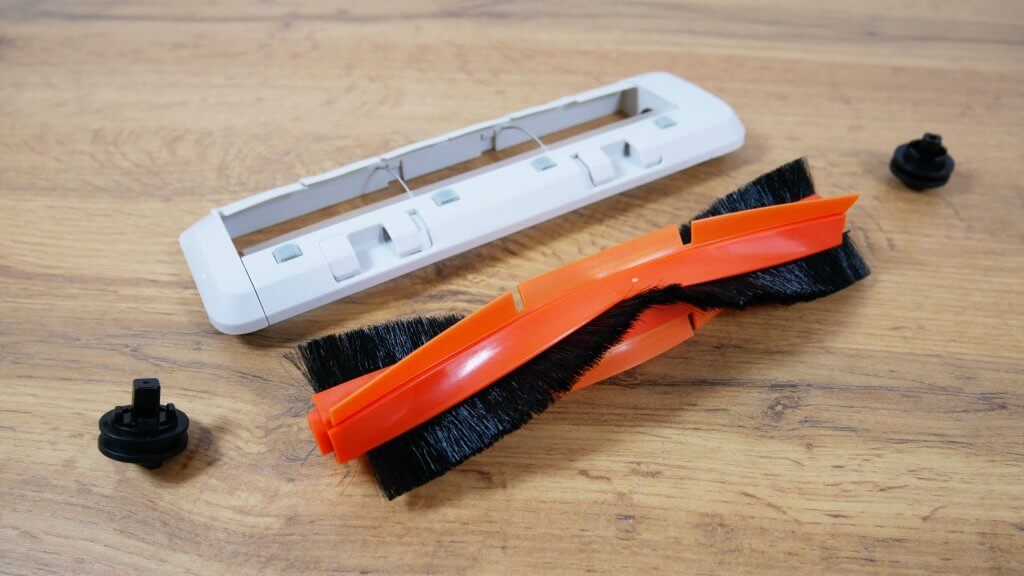
Useful life-hack! If necessary, you can order a silicone central brush for Dreame Boe L10s Ultra and install it in this robot. Such a brush is easier to clean from wound hair and wool. True, you need to order not only a brush, but also a cover. Since the original from Xiaomi presses the silicone brush. But it’s still cool that there is a possibility of replacement!
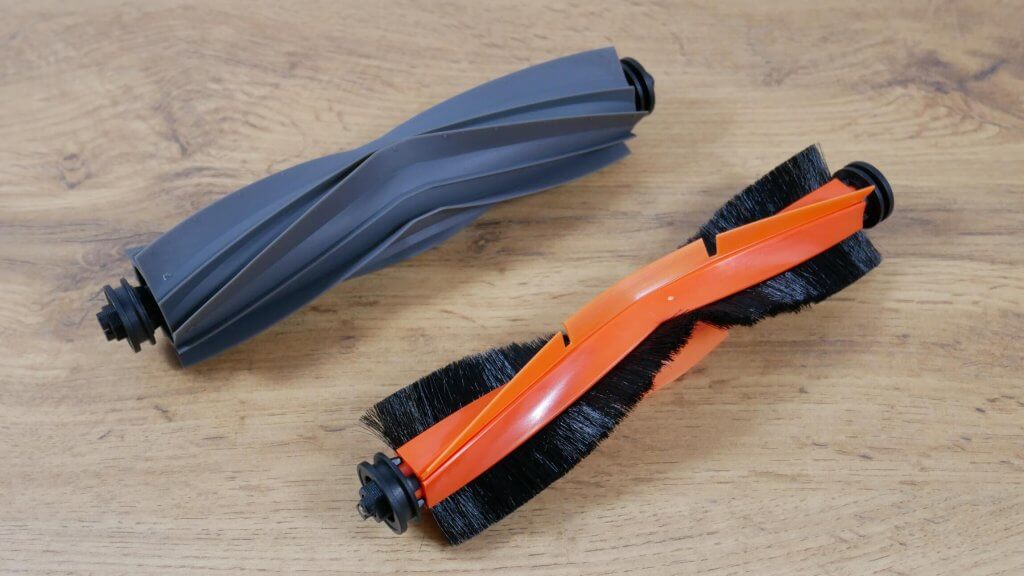
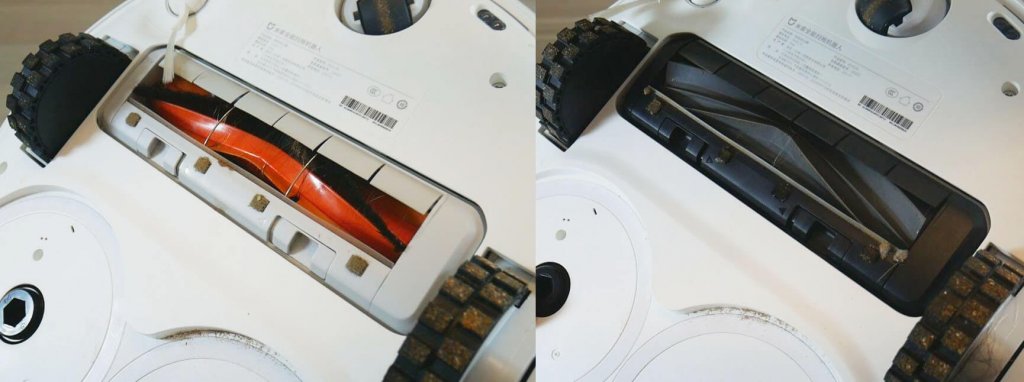
Mopping pads holders are attached with magnets. Mopping pads are attached to the holders with Velcro. Well, in fact, the mechanism for lifting mopping pads is implemented by twisting and unscrewing the platforms themselves. The lift height reaches 7 mm.
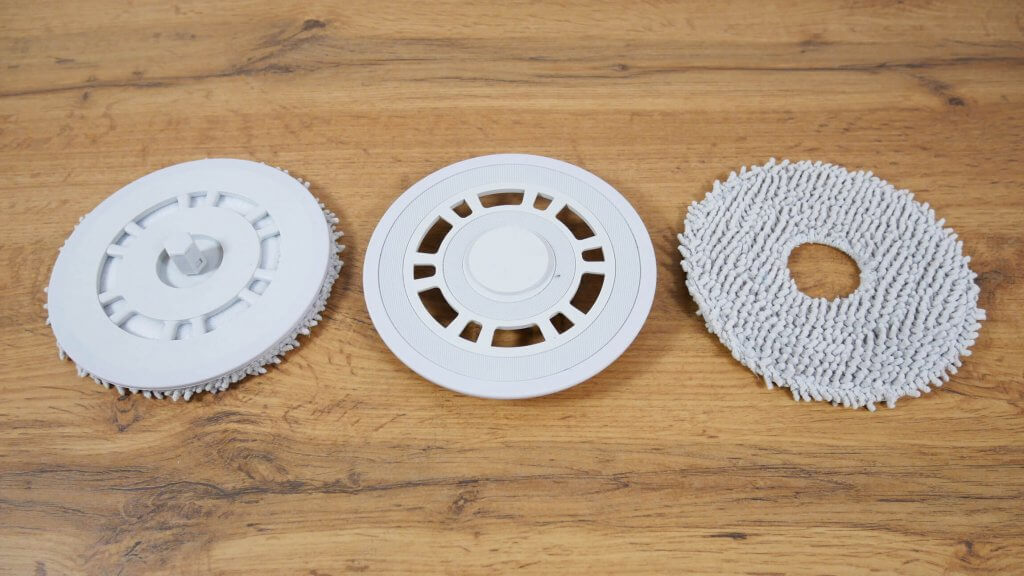
All clear with the robot. Let`s move on to the station. As in the case with Dreame, the platform is not removable, but the module can be removed for cleaning the mopping pads. There is a flat surface underneath that is easy to clean.

Above behind the cover with a mechanical lock there is a bag for self-cleaning of the dust collector. It holds up to 2.5 liters of dry waste. Under the top cover of the station there are tanks for dirty and clean water. They are standard. Capacity is 2.5 liters each. There is no place for a detergent tank, as it is implemented in the case with the Dreame Bot L10s Ultra.
Well, speaking of drying, mopping pads dry with hot air for two hours. This time is enough to dry them and prevent unpleasant smell to spread around the room.
Now about an important nuance. Mijia Omni B101CN has one problem from the factory. Not everyone has it, but I got just such a device. At the first start, the mopping pads are not wetted with water. Either an air lock is formed, or a weak pump, as they say on the forums. But the fact remains – the station is buzzing, trying to supply water, but nothing happens. There are two ways to solve this problem. The first is to turn on the forced rinsing of mopping pads through the application up to 5 times in a row. Approximately from the 5th attempt the water starts to flow and the problem is solved. The second option, as I did, is to disconnect the tube in the clean water tank, remove the filter, and when the robot tries to turn on the rinsing of mopping pads, with a help of syringe or mouth, having previously drawn water into it, blow the water into the tube. The pump will start and the problem is completely solved. Not a very pleasant situation, but the good thing is that it can be solved without service centers. By the way, Dreame, according to the reviews, has the same problem. But in my case, for example, I did not appear. It is a lottery.
Generally, apart from the nuance with pomp, there are no special comments on the robot.
Specifications
The main characteristics of Mijia Omni B101CN:
Robot Vacuum Cleaner:
- Battery Li-Ion 5200 mAh.
- Suction power up to 4000 Pa.
- Cleaning area up to 200 sq.m.
- Capacity of the dust collector is 350 ml.
- Capacity of the water tank is 80 ml.
- Passage of obstacles up to 20 mm.
- Dimensions: 350*97 mm.
Station:
- Power consumption: up to 1000 W.
- Clean water tank: 2.5 l.
- Dirty water tank: 2.5 l.
- Bag in the station: 2.5 l.
- Dimensions: 423*340*568 mm.
Here it is only important to check the suction power. The rest of the features are pretty standard.
Functionality
Speaking of control, the robot vacuum cleaner is designed for the Chinese market, so it connects to Mi Home through the China region.
Xiaomi Mijia Omni B101CN features:
- Self-cleaning.
- Rinse mopping pads at the station.
- Drying mopping pads with hot air.
- Objects recognition on the floor.
- Saving multiple cleaning maps in memory.
- 3D room map.
- Automatic zoning of the premises into rooms.
- Choice of zones and rooms for cleaning.
- Virtual walls and No-Go/No-Mop zones.
- Suction power adjustment.
- Setting the frequency of rinsing mopping pads (according to the room, after each 20 sq.m.).
- User mode.
- Cleaning log.
- Scheduled cleaning.
- Automatic power increase on carpet.
- Avoidance of carpets in the mopping mode.
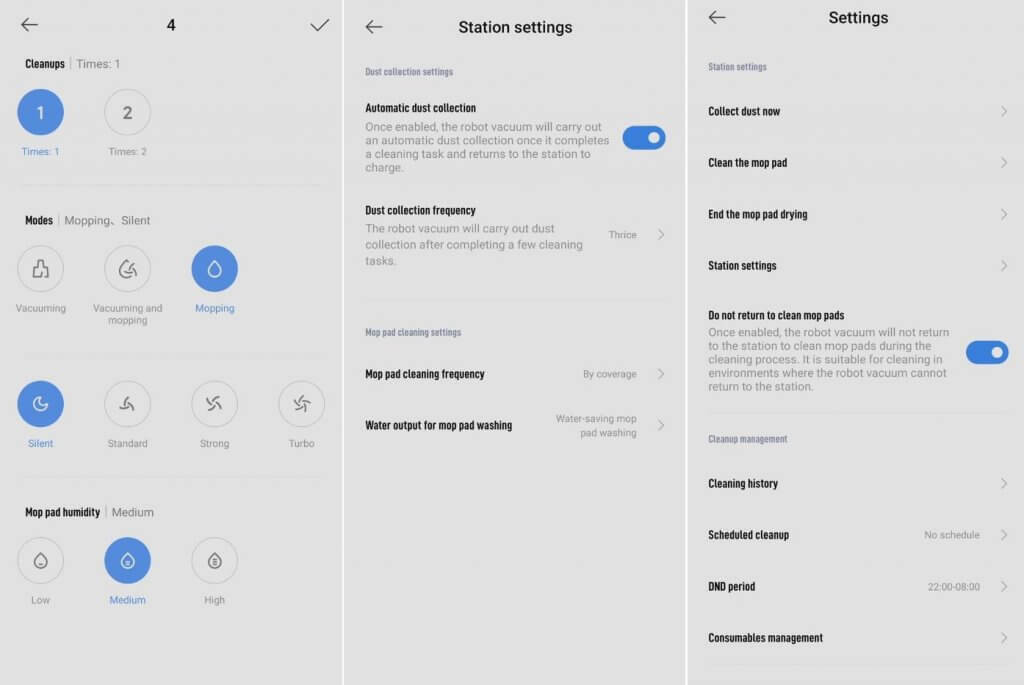
The possibilities are quite large. In my opinion, only the frequency of rinsing mopping pads is not implemented correctly. It is not possible to choose a different area value, but 20 sq.m., it is a fairly large interval. Even 15 sq.m. would be a better solution.
Well, this model does not have remote monitoring of the house. Only automatic detection of objects on the floor. If necessary, you can disable this function if, for example, on carpets, the robot starts to drive in circles or go around carpets. But I did not notice such a problem during testing.
Testing
Navigation
And finally, let’s move on to the tests. First of all, let’s check the navigation of the Mijia Omni in the room with obstacles. The robot vacuum cleaner first passes around the perimeter of the room, then cleans the entire available area with a snake. He identified the legs of the dryer and carefully drove around. At the same time, it separately swept around the box and the legs of the chairs, after which returned to the station. Test passed successfully.
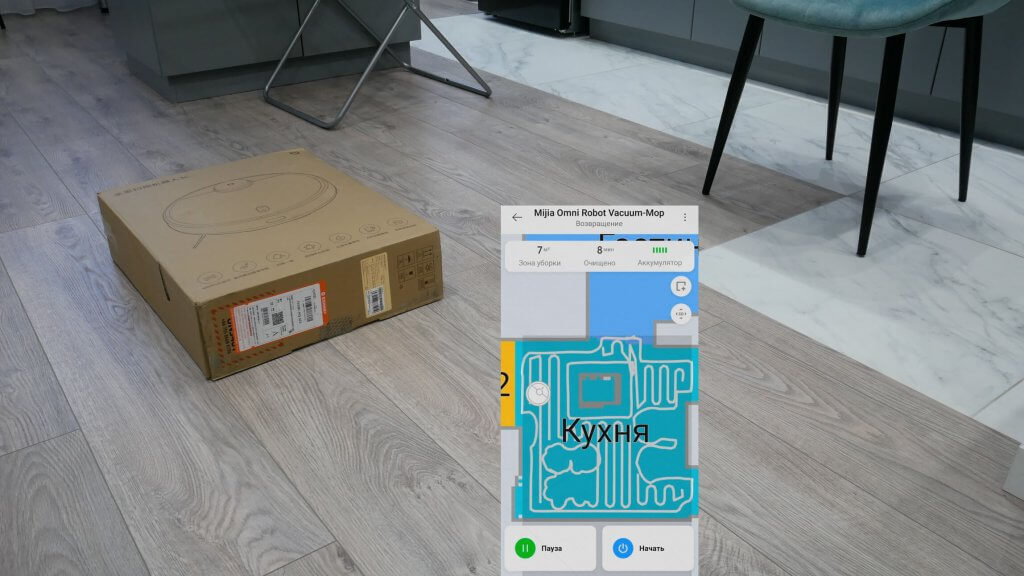
Speaking of navigating within the home, the robot vacuum cleaner cleans room after room around the perimeter, then with a snake. Every 20 sq.m., as I noticed, it returns to the station and rinses the mopping pads, after which it starts cleaning from the place where previously finished. As a result, the apartment was cleaned with two intermediate arrivals at the station. There are no uncleaned areas left, navigation in this model is good!
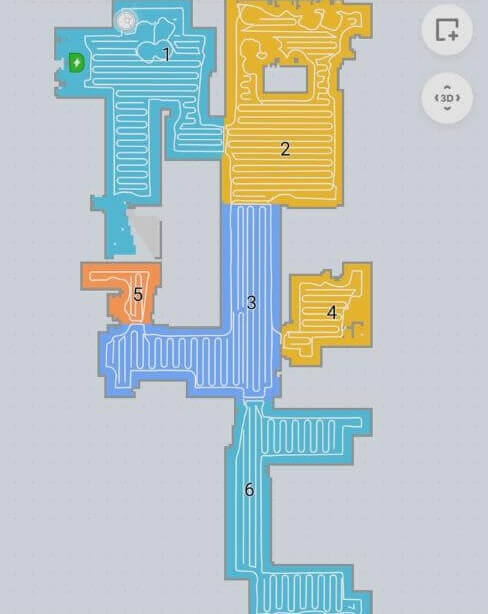
Objects detection
Objects detection system during the day is well implemented in this robot. It was able to accurately drive around all 6 items on the floor, including the simulated pet surprise. However, certain items are not marked with corresponding icons on the map. So, there are doubts that the robot vacuum cleaner recognizes them. At least there is no confirmation of this, comparing with Dreame.
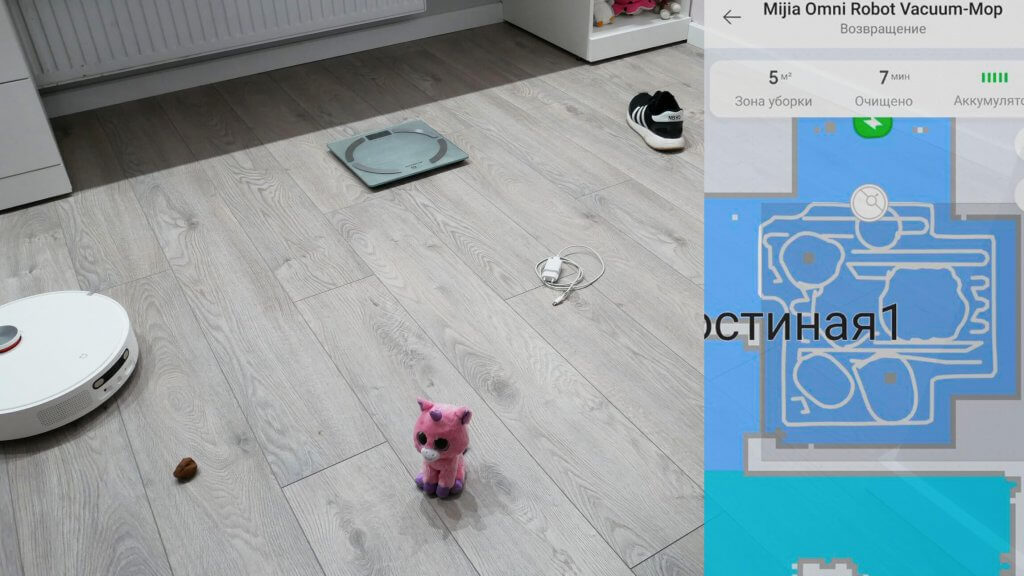
Well, in complete darkness, the object detection system goes blind and the robot fell into almost every trap. Luckily, I didn’t get stuck and didn’t report an error. You should consider this moment.
Suction power
But speaking of suction power, here Mijia Omni very pleasantly surprised me. It was able to suck out debris even from a 10 mm gap and it’s very cool!
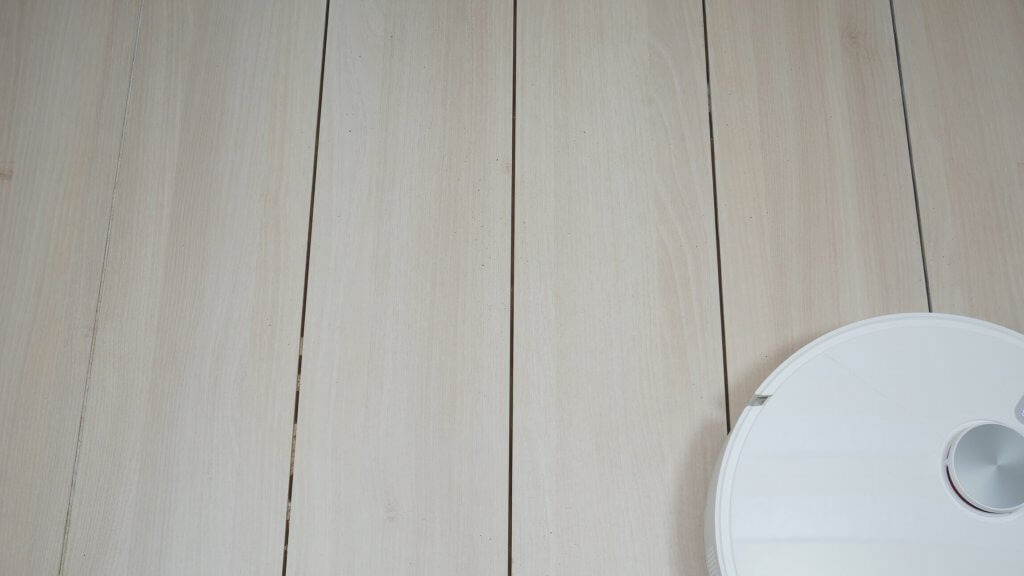
For comparison, Dreame Bot L10s Ultra showed the result, sucking debris out of only a 4 mm slot, and even then barely. So Mijia Omni is much more powerful in fact. I even tried changing the brushes because the silicone brush was blocking the suction. But no, with a bristle-petal brush Dreame showed even worse results, sucking debris out of only a 2 mm gap. In general, I repeat once again, Mijia Omni is more powerful, and this is a plus.
Dry cleaning
The quality of collecting different types of waste on the laminate is good. There remains only a little debris in the corners, from where round robot vacuum cleaners are not able to sweep. All debris is collected in the dustbin.

Moreover, it is important to consider the fact that the bristle-petal turbo brush has wound some of the hair and wool around itself. But if you put silicone brush from Dreame, the quality of cleaning will be the same, but the brush is much cleaner. Think about it. An interesting opportunity to upgrade your robot.
Carpet cleaning
The same garbage was scattered on the carpet, and Mijia Omni did a great job. Test passed successfully!

Mopping and carpets
Speaking of wet cleaning in the presence of carpets, you can choose one of two options for the behavior of the robot. The first is the automatic lifting of mopping pads when driving on carpets, which will allow the robot to vacuum at the same time and mop the floor, leaving carpets dry and clean. The second option is to turn on the automatic carpet avoidance function in the wet cleaning mode. This will be relevant in the presence of carpets with high and medium pile, in order to completely eliminate the contact of the mopping pads with the carpet if necessary.
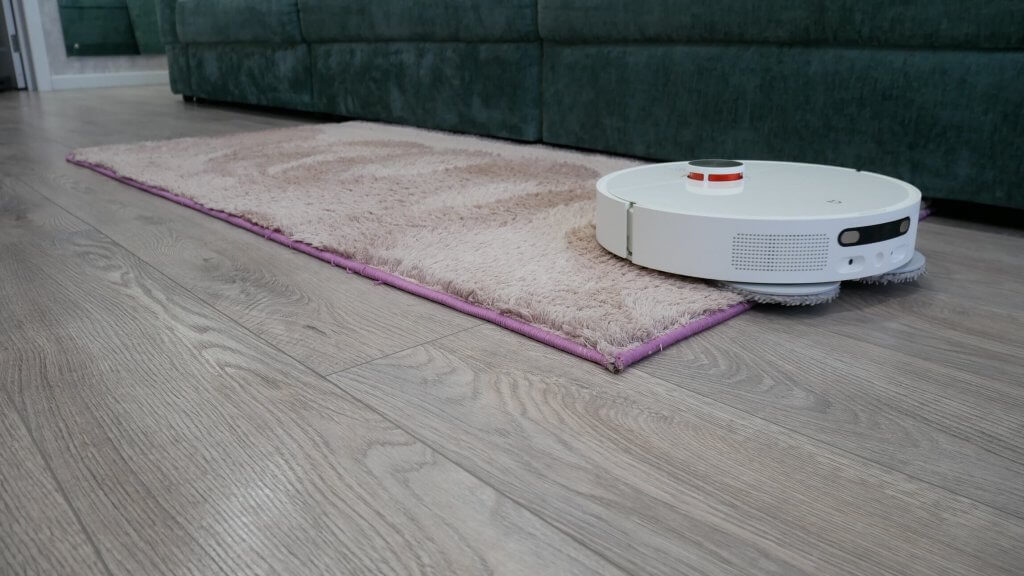
Rubbing off dirt
This robot vacuum copes with scrubbing off dirt, considering several rides to the station for rinsing mopping pads. This is the main advantage of such robots. Dirt won’t rub off on the floor during the entire cleaning. Accordingly, in several approaches, the robot can precisely wash the floor, and not just wipe it. As predicted, a narrow section of the floor along the plinth remained unwashed due to the fact that the mopping pads do not come out to the edges. This is a problem with all robot vacuum cleaners that we had on tests.

Quality of rinsing mopping pads
Well, I would like to test the quality of the station itself. Let’s start with the quality of rinsing mopping pads. In domestic conditions, after washing the floor, the condition of the wipes is not very bag. And after rinsing mopping pads, I can say that they are actually clean. The minimum amount of dirt is washed out under the pressure of warm water. This is a plus!
But when testing in my case after a stand with dirt, the robot did a very poor job of rinsing the mopping pads.
Under the water pressure, a lot of dirt washed out and it’s strange. Maybe there is a problem with the pump again. It is unclear.
And here’s how easy it is to clean the platform at the station after complex tests. Service was pretty easy!

Self-cleaning quality
The self-cleaning quality of the dust collector is almost ideal. I started the robot vacuum cleaner in a room with a lot of debris. It removed everything and we see that the dust collector is tightly packed with debris, including wool and hair. We return the robot vacuum cleaner to the station and see that the container is completely cleaned after self-cleaning. Self-cleaning is well implemented in this robot!
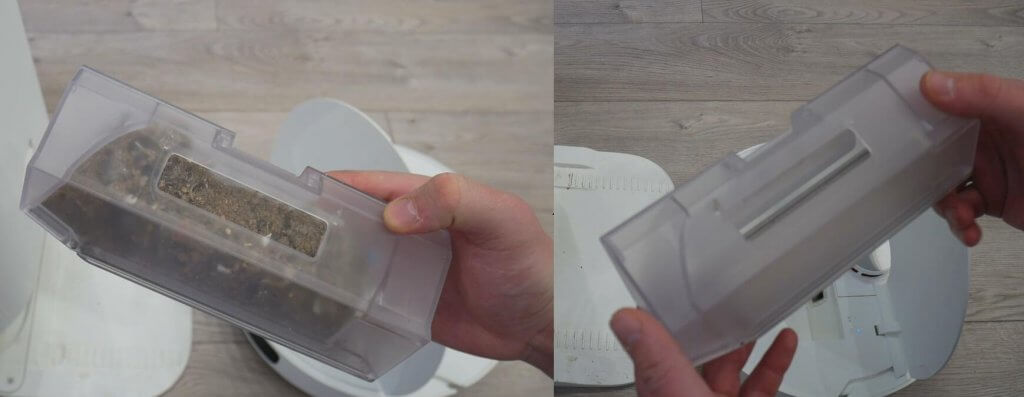
Passage of obstacles
Mijia Omni passes 2 cm sills without problems, while raising mopping pads. This is a plus!
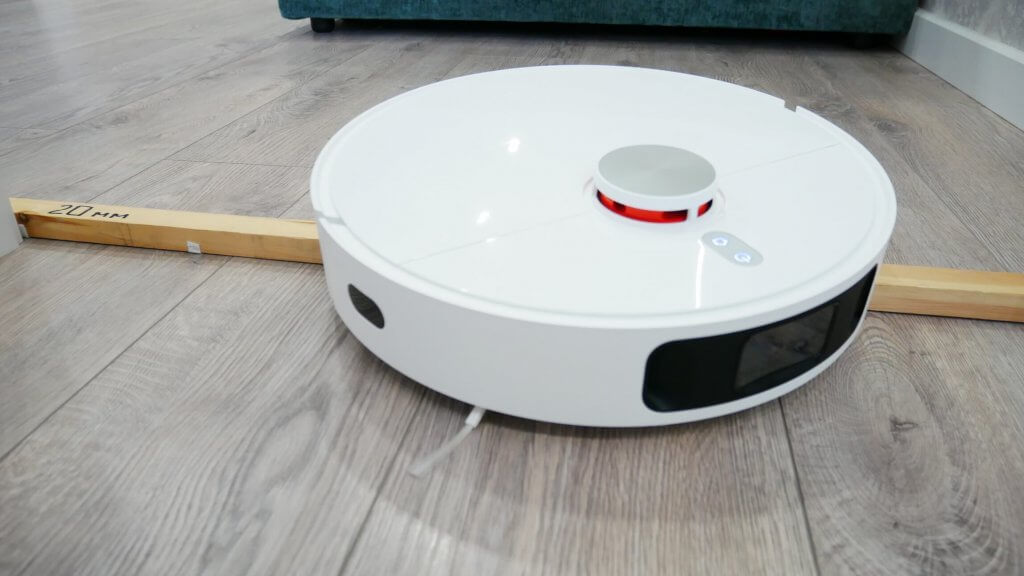
Passage of dark surfaces
It is also not afraid of dark surfaces, freely driving on a completely black rug. This is another advantage of the robot!
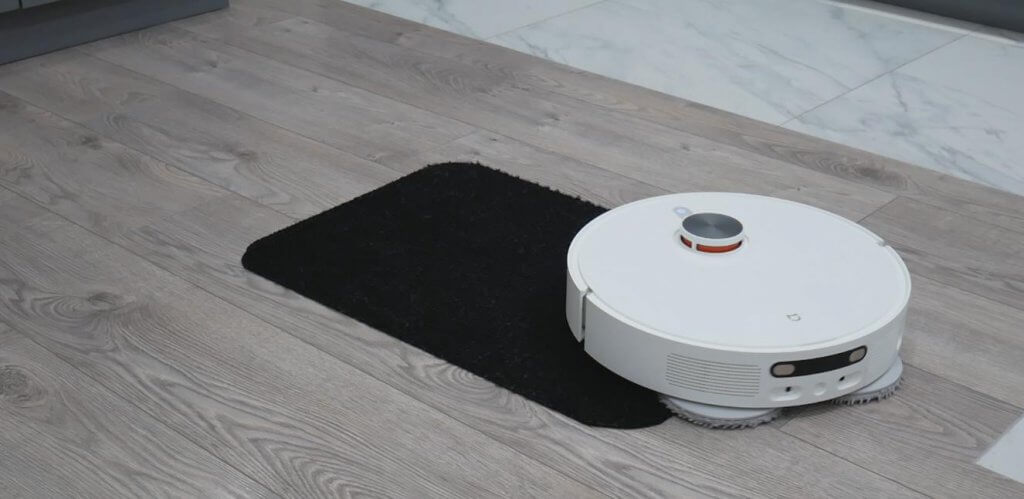
Noise level
Well, as for the noise level, with the suction turned off, it is in the range of 58-60 dB. At standard power level noise rises to 61 dB. In the “Strong” mode, the noise level rises to 63-64 dB, and at maximum power the peak value was 73 dB. Yes, at maximum power the noise level is high, but the suction power is also high, which is connected.
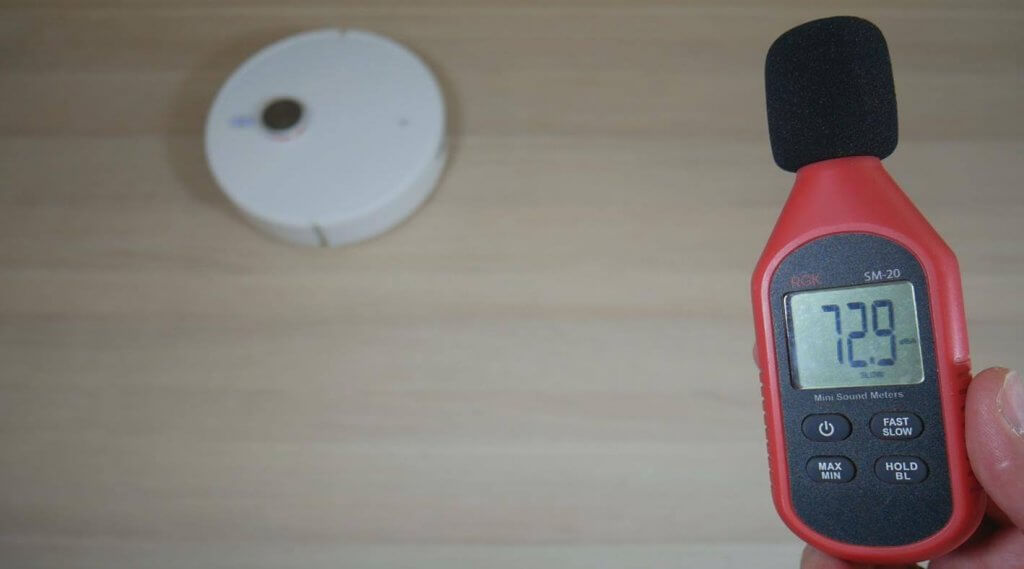
Personal opinion
Xiaomi Mijia Omni Robot Vacuum-Mop B101CN was reviewed and tested in detail. On our rating system, it managed to score 165 points, making it one of the top three tested robot vacuum cleaners in 2022. Slightly less than its main competitors Roborock S7 MaxV Ultra and Dreame Bot L10s Ultra. But the price is 2 times less and this is a very important argument in favor of Xiaomi.
Overall rating: https://robotobzor.com/ratings/general-rating-of-robot-vacuum-cleaners.html.
First, let’s talk about the pros and cons of the robot, then I will express my general impression after tests. What I liked:
- Accurately detects objects on the floor in the daytime.
- The combined station for self-cleaning and rinsing of mopping pads.
- Effectively dries mopping pads with hot air.
- High-quality self-cleaning and rinsing of mopping pads.
- High-quality dry and wet cleaning on any surfaces.
- Very high suction power.
- The robot vacuum cleaner is able to vacuum and mop the floor at the same time.
- Two rotating mopping pads are better at scrubbing dirt.
- Automatic lifting of mopping pads when driving on carpets.
- Convenient service station.
- A large number of functions for flexible adjustment of cleaning parameters.
- Good passage ability.
- The robot vacuum cleaner is not afraid of dark surfaces.
- Low noise level.
- If necessary, you can buy and install a silicone turbo brush instead of a bristle-petal one.
- The best price considering the functions.
Speaking about the shortcomings, during the tests, that’s what I found, comparing with analogues:
- From the box there are problems with the water supply when rinsing mopping pads. But it’s good that everything is solved.
- In complete darkness, the object detection system goes blind.
- The robot vacuum cleaner does not sweep debris in the corners.
- Does not scrub a narrow area along the plinth.
- There is no way to connect the station to the sewerage and water supply.
Speaking of the last note, the new Mijia OMNI 1S has already been released, the station of which can be connected to the sewerage and water supply, and is also equipped with a detergent tank, like Dreame. And the price of the robot is the same. So, for whom it is important, it makes sense to order an updated model, a link to which I also posted in the video description. And so, the shortcomings are either typical for analogues, or minor, given the price.
In any case, in my opinion Xiaomi Mijia Omni Robot Vacuum-Mop B101CN is definitely the best robot vacuum cleaner under the cost $700 in 2023. It’s powerful, tidy and yet does a good job of both cleaning and self-cleaning. In general, definitely TOP for its cost and in my subjective opinion, this is a more interesting model, compared with the closest analogues Roidmi EVA and Lydsto W2. At least, given the very high real power, the objects detection system, the function of lifting mopping pads on carpets, and the availability of consumables, as well as spare parts. I think it will not move from the TOP-5 robots anytime soon.
On this note, I would like to end the review. If you have any questions, ask them in the comments below . Happy tech shopping. Bye!


